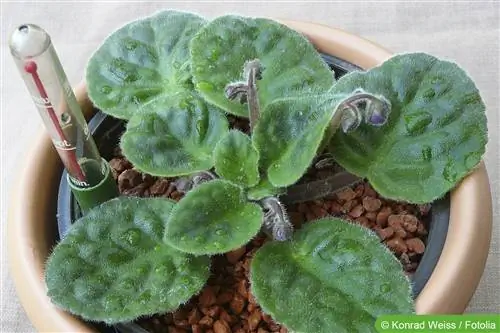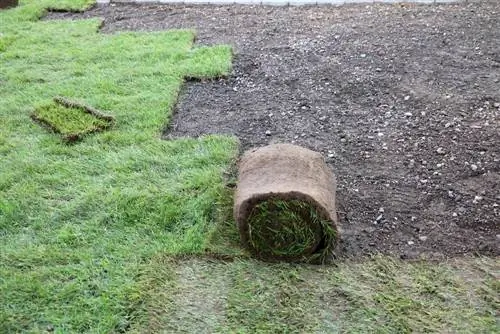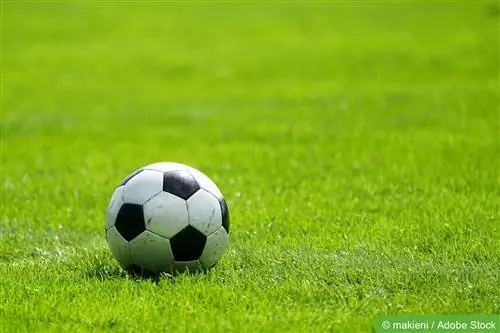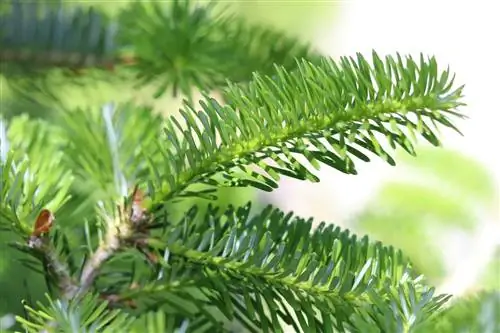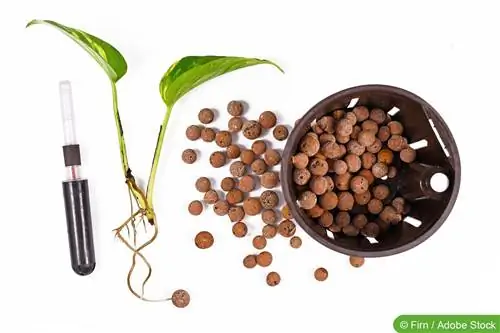- Author admin [email protected].
- Public 2023-12-17 03:39.
- Last modified 2025-06-01 06:48.
Hydroponics is a way of growing plants that differs from the traditional way. The classic plant-soil system is not used here, but rather a growing substrate made from expanded clay. The special thing about it is that it is considered the first system for the long-term keeping of plants.
What is hydroponics - which plants are suitable?
“Hydro” comes from Greek and means “water”. In hydroponics we find a precisely coordinated system. The focus is on the plant, although it should be mentioned that there are over 300 plants that are suitable for this type of plant husbandry. A so-called culture pot, which is filled with expanded clay, is used as a plant container. The expanded clay is rot-proof and gives the plant the support it needs. In addition, the water is transported upwards to the plant. The culture pot provides the plant with an ideal supply of water and the necessary nutrients. This disappears into a waterproof planter, which can be chosen depending on your home and taste. The water level indicators are important, as they show precisely how much water the plant needs. A so-called fertilizer pipe is used so that optimal nutrient exchange can take place. This is added directly to the water supply and lasts for three months. All hydroponic plants, whereby it is important to pay attention to the described handling of the respective fertilization.
Suitable plants are:
- Leaf and green plants, such as: the birch fig and the dragon tree,
- Palms, such as: the Kentia palm and the Yucca palm,
- Ferns, such as: the sword fern and the nest fern,
- Climbing plants, climbing and hanging plants, such as: the climbing fig and Russian wine,
- Flowering plants, such as: the flamingo flower and the Christ thorn,
- Cacti, such as: the Schlumbergera and the western cactus.
Location and how to care for hydroponic plants
Even in hydroponics, plants have different requirements when it comes to temperature and light conditions. The specialist shops offer good advice and you should think beforehand about where the plant should be located and then buy accordingly. Basically you can say that these plants like a bright location. It should be borne in mind that, just like traditional plant systems, hydroponics can also react with diseases and pest infestations if handled improperly. Clear signs of an unhe althy change are the leaves becoming lighter and turning brownish at the edges. Often it is simply watering errors that contribute to damage to the plants - here's a tip: never fill the containers with more than a third of water. Only add water again when the water level indicator is at “minimum”.
Experienced hydroponics experts like to claim that this way of keeping plants is less complicated compared to growing plants with potting soil or the like. It is sufficient if a weekly visual check of the water level is carried out, watering must then be carried out every 14 days, quarterly fertilization is sufficient - as is leaf care, the plant needs to be completely serviced once a year and repotted only about every five years. If this is taken into account, the longevity of the hydro plants can be ensured. If problems arise, a qualified hydroponic gardener or indoor landscaper can help. Fertilizers are simply added with the irrigation water; so-called long-term fertilizers, suitable for hydroponics, are ideal here. If you want to be on the safe side when caring for these plant cultures, you can conclude a so-called care contract with an experienced hydrogardener. He then takes care of the plants professionally and does the necessary things at the right time so that the plants are well and can thrive.
Pest infestation and diseases in hydroponic plants
It can happen that the plants are attacked by pests such as black or green lice. Young shoots in particular can be damaged here, which is visible in the curling of the leaves, which also have a sticky coating. The cause can be a location that is too dry and warm. Suitable sprays, which are available in specialist stores and hardware stores with plant departments, can help here. If the air in the room is too dry, mealy bugs and mealy bugs can spread, leaving a woolly coating on the stems and leaves. Sprays that contain oil cause the lice to suffocate. Anyone who discovers brown bumps on the stems and leaves is dealing with the scale insect. The leaves also stick together and can become crippled. Similar to the mealybugs and mealybugs, the air here also seems to be too dry and oily sprays are used. And if you notice bright, silvery speckles on flowers and leaves, you are dealing with thrips, also known as bubble feet. The sucking out of the plant cells causes damage, which can be controlled with commercially available foliar sprays. The spider mites or red spiders are tiny mites or very fine webs that can be found on the underside and upper side of leaves. You can tell that this infestation is taking place by the drying of the leaves. Treatment: Increase the humidity and use plant protection against predatory mites.
Physical damage to hydroponic plants
- a water level that is too high,
- too dry air,
- a cold damage,
- Drafts,
- a nutrient deficiency,
- a calcium deficiency or
- a lack of light.
If you want to convert your plants to hydroponics, you usually won't have any problems. Young plants should preferably be used here. Despite the pests mentioned, hydroponic plants have significantly fewer pests and infestations than plants grown in soil. Hydroponics is also cleaner than traditional soil culture. The plants are easier to care for, more hygienic and less labor-intensive.
What you should know about hydroponics in brief
- Hydroculture means water culture and is a form of ornamental plant keeping.
- Hydro plants are grown as houseplants. However, the plants are not rooted in soil, but in so-called expanded clay.
- Because the expanded clay is porous, the roots are supplied with sufficient oxygen.
- Every three to six months, the plants should be covered with nutrient-rich plastic granules.
- The nutrients contained in it are dissolved by the water, which means that the plant is well supplied.
- Hydroponic plants/hydro plants and their containers usually have a water level indicator.
Switching from soil to hydroponics
It is usually easier to acclimate very young plants from soil to hydroponics. Older plants sometimes find it difficult to adapt. This has to do with the fact that the roots adapt to the specific conditions over time. Young plants adapt more quickly. Carefully rinse all soil away from the roots.
Advantages
The hydroponic plants can be treated cleanly, there are no soil pests, watering is less frequent and the root cannot rot. In addition, hydroponic plants are more robust and grow better than normal plants.
Disadvantages
Keeping some hydroponic plants such as cacti is difficult and the cost of hydroponics is higher than keeping plants normally
Alternative planters with irrigation system
Since the advent of planters with irrigation systems, hydroponics has been increasingly forgotten. The advantage of the new planters is that they are suitable for all plants. Whether cacti, succulents, palm trees, flowering plants, house or balcony plants, there is a suitable container for every plant.
Planters with an irrigation system from Lechuza are ideal, see www.lechuza.de. The sub-irrigation system is suitable for all plants that are cultivated in soil. So you don't have to buy special hydro plants. The plant substrate that comes with it is also practical. It stores the nutrients supplied to the plants as needed and up to 40 percent water while maintaining optimal air pore volume. The substrate supports root aeration and optimally doses the water supply.
A special substrate is also available that combines the benefits of organic humus with mineral components. It is particularly suitable for the company's outdoor planters, but is also suitable for indoor plants. It contains pumice, broken expanded clay and an effective fertilizer combination. Fresh natural clay acts as a nutrient reservoir and promotes an even supply of plants. The good thing about this special substrate is that water and air can circulate optimally in the root area. This is how many important hair roots are formed. These are important for the plants’ nutrient absorption. Overall, Lechuza planters are very practical and particularly suitable for plant lovers who don't have a lot of time for care or who don't have the so-called green thumb. The vessels take a lot of work off of you. However, they are expensive.

